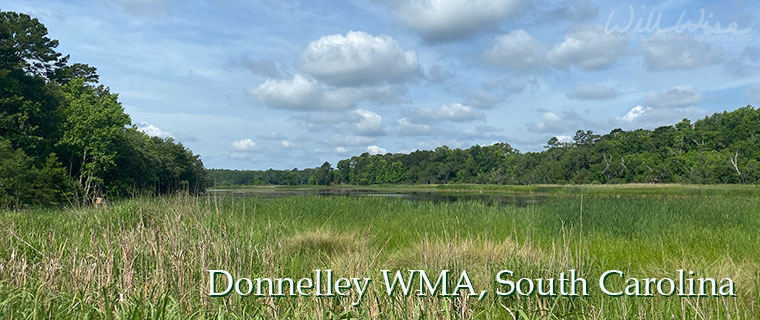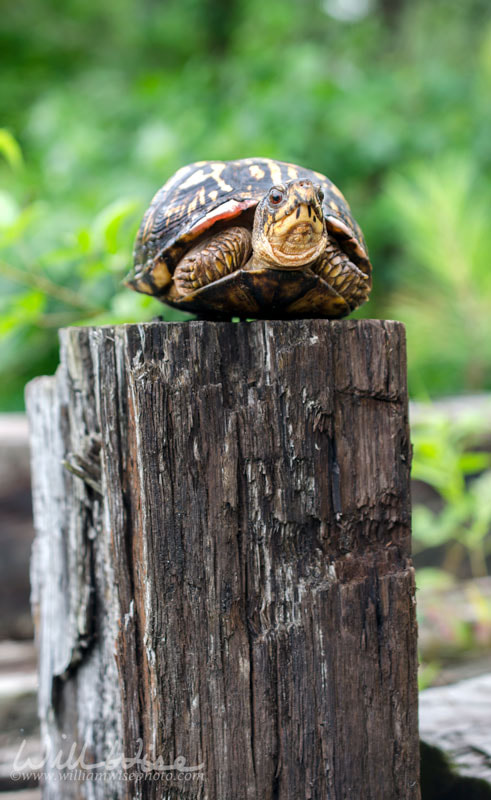From my 2021 nature journal...


© Photographer: William Wise | iNat Observation: 83615611 - Great Blue Heron; Donnelley WMA, South Carolina. June 5, 2021.
I wanted a place to get away for a day. It had to be within four hours from my home, had to have alligators, and would have plenty of trails to fill an entire day. Donnelley Wildlife Management Area in Colleton County, South Carolina fit the bill. Following observations on iNaturalist, I pinpointed Donnelley WMA as an alligator hotspot. I messaged a couple of iNat users that frequent the area and got some great tips. Although it is primarily managed for hunting, it was a great habitat for non-game species as well.
I woke up at 4:30 AM and was within the WMA by 8:30. I first drove the loop, stopping in a few locations to photograph a couple of gators. I finally parked and got out on Blocker Run Road alongside two large bodies of water where most of the alligator activity takes place. I wasn’t disappointed.

© Photographer: William Wise | iNat Observation: 81894360 - American Alligator; Donnelley WMA, South Carolina. June 5, 2021.
As soon as I exited my car at the Donnelley Wildlife Management Area in South Carolina, I knew it was going to be a good day! The morning was still calm and peaceful. But I as walked closer to the water, a large splash broke the glass surface of the marsh. A large American Alligator came up out of the water crunching a blue crab in its jaws!
Even if you never actually laid eyes upon an alligator at Donnelley WMA (which is virtually impossible), their evidence was all throughout the habitat. From tail drags and footprints in the mud, to multiple piles of clay-like droppings, the signs of crocodilians was everywhere!

© Photographer: William Wise | iNat Observation: 83259530 - American Alligator track; Donnelley WMA, South Carolina. June 5, 2021.
Although my primary reason for choosing Donnelley WMA for a day trip was alligators, I knew from iNaturalist users there would be plenty of birding photography opportunities as well. And I wasn't let down! I spent several hours walking the berms between the old rice fields getting my fill of long-legged wading birds and American Alligators. I was able to add 17 new species to my South Carolina list.

© Photographer: William Wise | iNat Observation: 82337731 - Anhinga; Donnelley WMA, South Carolina. June 5, 2021.

© Photographer: William Wise | iNat Observation: 83161476 - Green Heron; Donnelley WMA, South Carolina. June 5, 2021.
Coming around the corner of one of dirt roads that runs through the Donnelley Wildlife Management Area in South Carolina, I interrupted a Turkey Vulture scavenging an afternoon lunch of Armadillo and Cottonmouth. I would much rather have photographed the Cottonmouth alive!

© Photographer: William Wise | iNat Observation: 82611304 - Turkey Vulture; Donnelley WMA, South Carolina. June 5, 2021.
The day was getting late, the humidity was getting high, and my feet were getting tired. But as I passed a canal along the Boynton Trail at Donnelley Wildlife Management Area, I saw a splash from the corner of my eye and heard that wonderful little chirp. Baby gators! I could see about fourteen babies in the pod... and hear several more. Two were larger sized - perhaps from last year's clutch. I didn't get to photograph them all, but was careful not to post duplicates on iNaturalist.

© Photographer: William Wise | iNat Observation: 82732407 - Juvenile American Alligator; Donnelley WMA, South Carolina. June 5, 2021.
Later in the afternoon I walked out to the Tupelo Swamp and circled the entire Boynton Trail. The WMA’s website was completely accurate in stating that the WMA hosts hundreds of gators. Over the course of my wanderings, I photographed 112 individual alligators within Donnelley WMA. The intermittent clouds blocked the sun, but the low country humidity made my feet stumble by late afternoon. I left Donnelley around 4 PM, just before the thunderstorms rolled in. It was a beautiful place with a variety of habitats, and I’m sure to return!
Donnelley Wildlife Donnelley Wildlife Management Area; Colleton, South Carolina, USA.
- Sun and clouds with afternoon thunderstorms. High of 86 F.
- Sunrise 6:15 AM, Sunset 8:27 PM
- Day length: 14 hours, 12 minutes (+40s)
- Moon 19% Waning Crescent
























